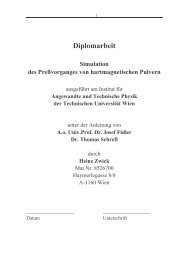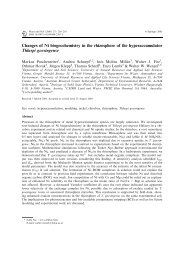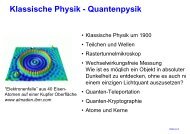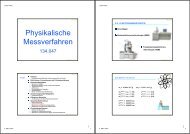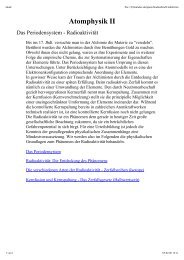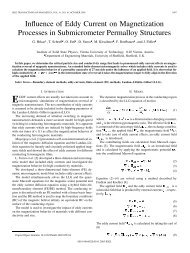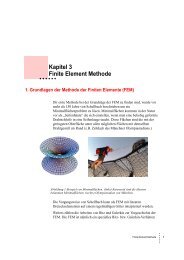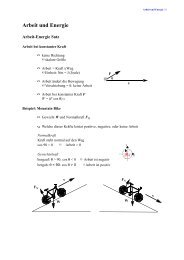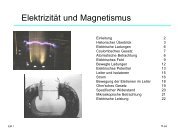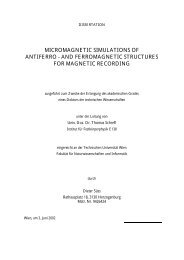Read Back Signals in Magnetic Recording - Research Group Fidler
Read Back Signals in Magnetic Recording - Research Group Fidler
Read Back Signals in Magnetic Recording - Research Group Fidler
Create successful ePaper yourself
Turn your PDF publications into a flip-book with our unique Google optimized e-Paper software.
List of Figures<br />
(right). Red color represents magnetization <strong>in</strong> positive x-direction and blue color<br />
magnetization <strong>in</strong> negative x-direction. The scale is <strong>in</strong> µm, thus the bit length is<br />
approximately 40 nm. The data layer thickness is 12 nm. ..............................................35<br />
Figure 3.6: The effective fields of the record<strong>in</strong>g layers (shown <strong>in</strong> Figure 3.5) as<br />
function of the head’s position. The dashed l<strong>in</strong>es <strong>in</strong>dicate the boundaries of the<br />
record<strong>in</strong>g layer model......................................................................................................36<br />
Figure 3.7: The simplified read head model (left) for perpendicular record<strong>in</strong>g. In the<br />
right picture the mirror heads are <strong>in</strong>dicated, which replace the SUL with its high<br />
permeability [22]. ............................................................................................................37<br />
Figure 3.8: The x- and the z-component of the normalized head field for perpendicular<br />
record<strong>in</strong>g..........................................................................................................................38<br />
Figure 3.9: a) Application of Ampere’s Law on the dashed path, b) application of<br />
Gauss’s Law on the dashed box. .....................................................................................39<br />
Figure 4.1: Typical basis functions of two neighbor<strong>in</strong>g nodes of a 2-dimensional mesh......43<br />
Figure 4.2: The left figure shows a set of 10 nodes after renumber<strong>in</strong>g and the<br />
cluster<strong>in</strong>g. The right figure shows the associated boundary matrix structure. The<br />
large off-diagonal blocks, correspond<strong>in</strong>g to far field <strong>in</strong>teractions of two clusters,<br />
can be approximated by low-rank matrices [25]. ............................................................49<br />
Figure 4.3: Hϕ for an <strong>in</strong>f<strong>in</strong>ite long wire is plotted over the distance from the middle<br />
axis. The second curve shows the error of the numerical calculation.............................55<br />
Figure 4.4: The model of the coil (left). The color code shows the l<strong>in</strong>ear decrease of<br />
the electric potential <strong>in</strong>side the wire. The chart (right) shows the magnetic field of<br />
a solenoid <strong>in</strong> z-direction at the middle axis. The two dotted l<strong>in</strong>es identify the<br />
position of the solenoid. The second graph shows the relative error of the coil’s<br />
magnetic field calculated with FEM calculation compared to the solenoid’s field. .......56<br />
Figure 4.5: Schematic diagram of the simulation cycle. Adapted from [31]. ........................58<br />
Figure 5.1: The shift of the hysteresis loop after a field cool<strong>in</strong>g treatment of a<br />
ferromagnetic/antiferromagnetic system [19] and the temperature dependence of<br />
the exchange bias field for NiFe(4-8nm)/Cu(2.2nm)/CoFe(2nm)/IrMn(15nm) sp<strong>in</strong><br />
valves with different free layer thicknesses [33].............................................................60<br />
Figure 5.2: A comparison (left) of a conventional sp<strong>in</strong> valve and a sp<strong>in</strong> valve us<strong>in</strong>g a<br />
synthetic ferromagnet to fix the p<strong>in</strong>ned layer [20]. The <strong>in</strong>terlayer exchange<br />
constant (right) for two Ni80Co20 layers as function of the Ru spacer layer<br />
thickness [32]...................................................................................................................62<br />
Figure 5.3: The effect of the sense current direction on the free layer (FL). For the first<br />
case (left) the current field Hcurr partially cancels the stray field HS of the p<strong>in</strong>ned<br />
layer (PL) and weakens the exchange bias field Hexch. For the other current<br />
direction (right) the stray field and the exchange bias field are supported by the<br />
current field. ....................................................................................................................63<br />
Figure 5.4: The layers of the GMR element also see mirror currents due to the high<br />
permeability of the shields. The field of these mirror currents is able to reduce the<br />
field of the orig<strong>in</strong>al current at the free layer and the p<strong>in</strong>ned layer. .................................63<br />
84



